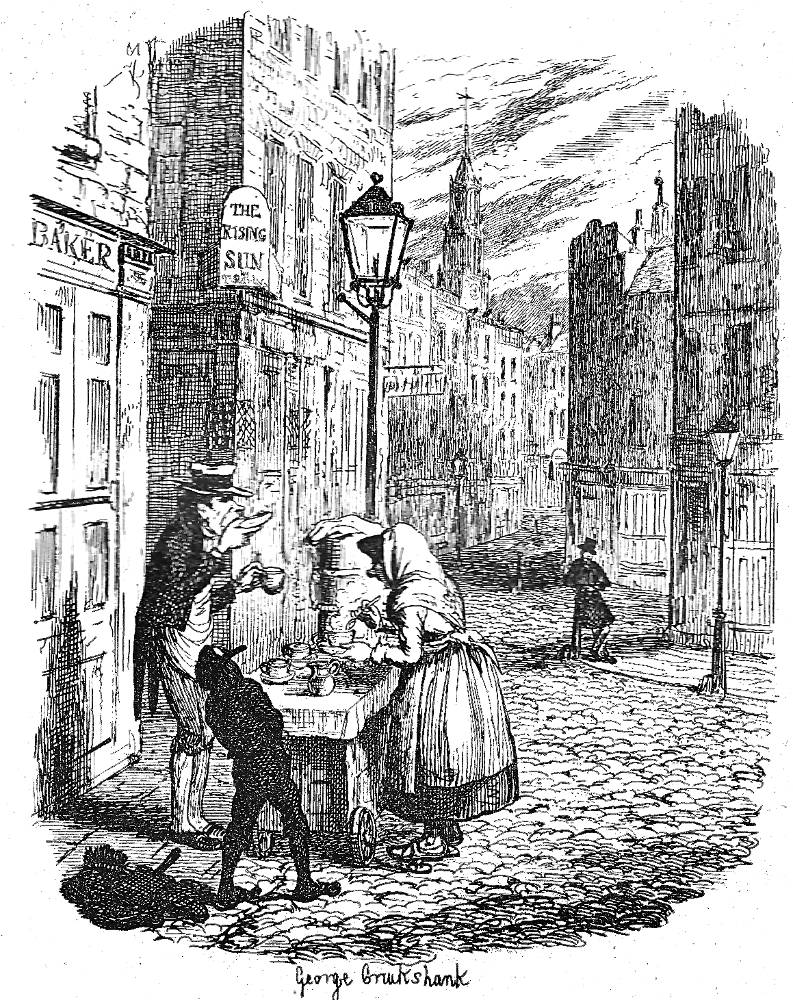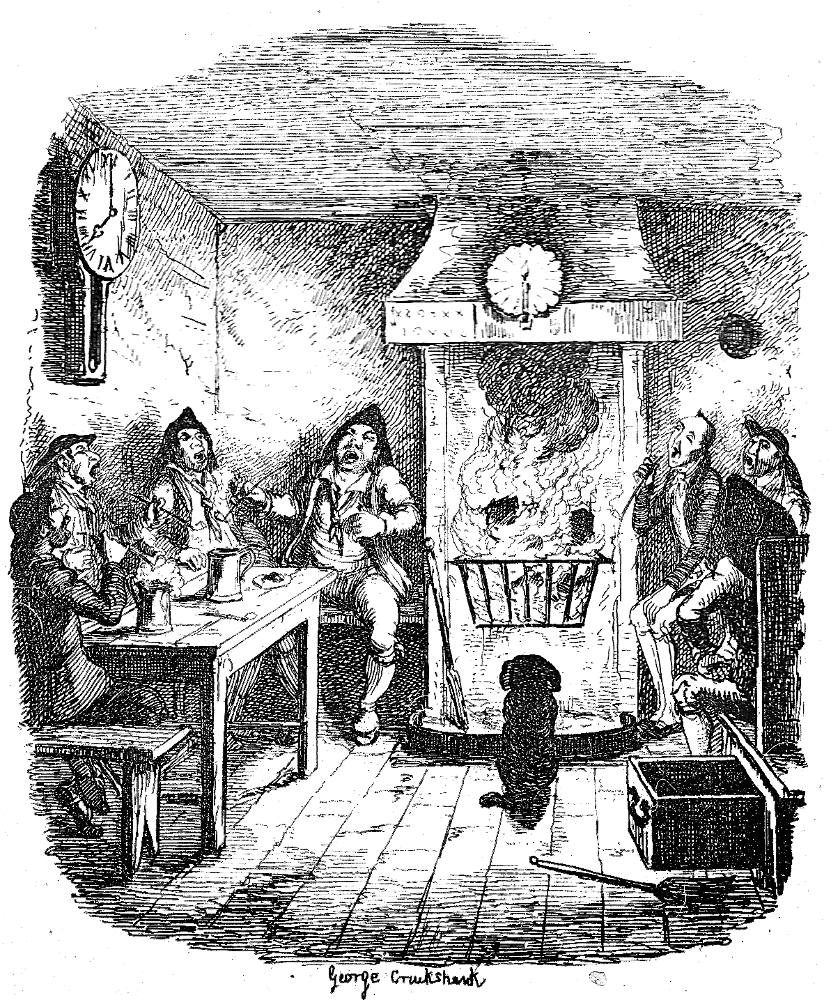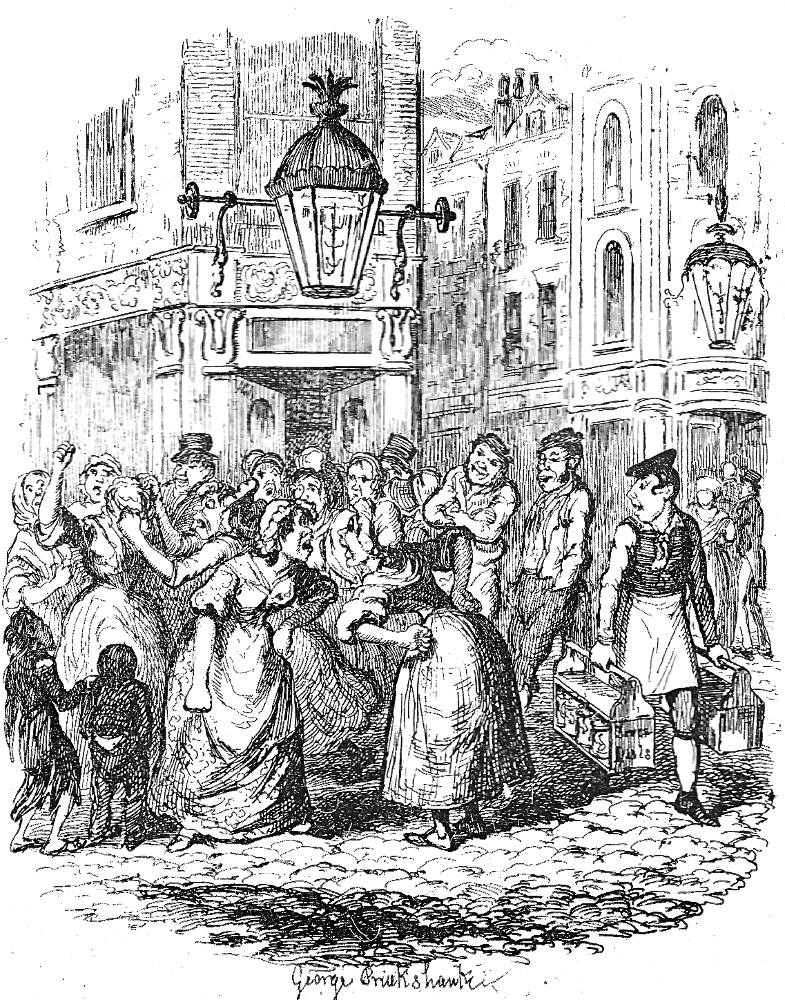
Knock loud double knocks at the door" in Chapter III of "Scenes" — "Shops and Their Tenants," in Dickens's Sketches by Boz Illustrative of Every-day Life and Every-Day People (Household Edition, 1877, middle of page 112. Wood-engraving; 4 ¼ by 5 ¼ inches (10.8 cm high by 13.4 cm wide), framed. Although one child in a particularly ragged set of clothes is practising her "double-knock" the background as in the text, Frost has added four urban waifs playing with a crude cart and a decrepit area-railing (centre).
Scanned image, colour correction, sizing, caption, and commentary by Philip V. Allingham. [You may use this image without prior permission for any scholarly or educational purpose, as long as you (1) credit the person who scanned the image, and (2) link your document to this URL in a web document or cite the Victorian Web in a print one.]
Passage Illustrated: Decaying Shops in "Scenes"
There is one, whose history is a sample of the rest, in whose fate we have taken especial interest, having had the pleasure of knowing it ever since it has been a shop. It is on the Surrey side of the water — a little distance beyond the Marsh-gate. It was originally a substantial, good-looking private house enough; the landlord got into difficulties, the house got into Chancery, the tenant went away, and the house went to ruin. At this period our acquaintance with it commenced; the paint was all worn off; the windows were broken, the area was green with neglect and the overflowings of the water-butt; the butt itself was without a lid, and the street-door was the very picture of misery. The chief pastime of the children in the vicinity had been to assemble in a body on the steps, and to take it in turn to knock loud double knocks at the door, to the great satisfaction of the neighbours generally, and especially of the nervous old lady next door but one. Numerous complaints were made, and several small basins of water discharged over the offenders, but without effect. In this state of things, the marine-store dealer at the corner of the street, in the most obliging manner took the knocker off, and sold it: and the unfortunate house looked more wretched than ever.
We deserted our friend for a few weeks. What was our surprise, on our return, to find no trace of its existence! In its place was a handsome shop, fast approaching to a state of completion, and on the shutters were large bills, informing the public that it would shortly be opened with "an extensive stock of linen-drapery and haberdashery." ["Scenes," Chapter III, "Shops and Their Tenants," page 111]
Commentary: Rejuvenating Derelict Shops in "Scenes"
Whereas the trajectory of most of the shops which Dickens describes dips sharply from tenant to tenant, the fate of this particular shop holds some promise for a better future in the metropolis. The removal of the brass knocker should signal the ultimate demise of this commercial space, but the repurposing of the shop proves highly successful. Whereas Barnard's illustration for "Scenes" depicts a gloomy, rainy night in this economically distressed area of London and the original George Cruikshank illustration for "The Streets: Morning" suggests neither prosperity nor gloom as the fate of the City, Frost, taking a more light-heared approach, delights in depicting the tattered children playing on he steps of the shop.
Originally published in The Morning Chronicle on the 10th of October, 1834, as "Street Sketches No. 2," the piece mingles humorous description and pathetic characters typical of the poorer districts south of the Thames ("The Surrey Side") in the 1830s. Although neither Cruikshank in the first volume edition nor Fred Barnard in the Household Edition illustrated this particular sketch, they offered visualisations for such grey-melancholy pieces as "The Streets Morning" and "The Streets Night." Indeed, A. B. Frost may have selected this particular sketch for elaboration not merely because of the possibility for presenting children at play, but simply because it had not already been illustrated. Again, this is not the London of politics, high fashion, the theatre, or the upper class, but rather the lower middle-class London of small shop-keepers; as Lucinda Dickens Hawksley remarks, the slightly dingy London "of ordinary people doing everyday things" (14).
A. B. Frost has chosen to provide a fresh visual commentary to complement one of the original illustrations by George Cruikshank, who in 1837 had depicted the normally bustling street as unusually tranquil before business hours in "The Streets by Morning." Frost focuses not upon the moribund business climate of the Surrey side, but rather on how play and a sense of community liberate the neighbourhood children from poverty. Since Frost was probably aware of Dickens's describing the Artful Dodger in the ninth monthly instalment of Oliver Twist; or, The Parish Boy's Progress (originally, December 1837) as wearing cast-off adult clothing (seen in the steel-engraving Master Bates explains a professional technicality, he may be alluding to that character in the child wearing the greatcoat (left, on the steps). Of course, he may have also seen poor children in the New York slums similarly attired, so that his costuming the small waif on on the left of the doorstep in adult attire much too large for him may suggest "drawing from life" as well as building on the work of a previous illustrator. The military cut of the garment may even imply that it is "army surplus," a vestige of the Civil War.
Relevant Illustrations from the Original (1837) and The Household Editions (1876)



Left: The original Cruikshank engravings, First Series (1836: 16 plates) for "Shops and Their Tenants": the Second Series of 1837 added "The Streets by Morning," "The Streets by Night," "Scotland Yard," and "The Seven Dials." Left: The Streets, Morning (1837). Centre: Scotland Yard (1837). Right: The Seven Dials (1837).

Above: Fred Barnard's realistic wood-engraving of a miserable night in the metropolis for Dickens's second essay, "The Streets — Night," in "Scenes": It is nearly eleven o'clock, and the cold thin rain, which has been drizzling so long, is beginning to pour down in good earnest. [Click on the image to enlarge it.]
Bibliography
Barnard, J. "Fred" (il.). Charles Dickens's Sketches by Boz, with thirty-four illustrations. The Works of Charles Dickens: The Household Edition. 22 vols. London: Chapman and Hall, 1876. Volume 13.
Bentley, Nicholas, Michael Slater, and Nina Burgis. The Dickens: Index. Oxford: Oxford U. P., 1990.
Dickens, Charles. Pictures from Italy, Sketches by Boz and American Notes. Illustrated by Thomas Nast and Arthur B. Frost. New York: Harper & Brothers, 1877 (copyrighted in 1876).
Dickens, Charles. "Shops and Their Tenants." Chapter 3 in "Scenes."Sketches by Boz. Illustrated by George Cruikshank. London: Chapman and Hall, 1839, rpt. 1890.
Hawksley, Lucinda Dickens. Chapter 3, "Sketches by Boz." Dickens Bicentenary 1812-2012: Charles Dickens. San Rafael, California: Insight, 2011. Pp. 12-15.
Last modified 28 May 2019